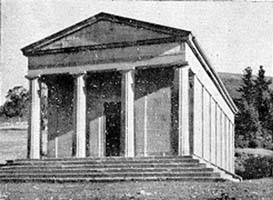 |
 |
|
Art Galleries
First mention must be of the Lady Franklin Museum, built in 1842 as a museum by Lady Franklin to house sculptures, paintings, prints and books. The Art Society of Tasmania, founded in 1884, leased the building from 1948. The Queen Victoria Museum and Art Gallery (1891) heads the list of regional public galleries in the north of the state, with other notable galleries such as Devonport Gallery and Arts Centre (1966) and Burnie Regional Art Gallery (1978). Commercial galleries have come and gone over the years. Credit for the earliest must go to Paul Schneider who opened the gallery at Carrick in the 1950s; then Jean Thomas began the Little Gallery at Devonport in the 1960s. Neither still operates. The current crop includes the Colonial Gallery at Evandale (1972), Ritchie's Mill, Launceston (1977) and Bowerbank Gallery at Deloraine (1978). The north-east is strangely barren with nothing of note in the main centres apart from historical societies. The east coast has a commercial gallery at Bicheno and, like most other places in Tasmania, boasts a wonderful pure light so much admired by the artist. Hobart is well served by galleries. Leading the way is the major state gallery, the Tasmanian Museum and Art Gallery (collections started 1843, institution came into being in 1885), followed by the John Elliot Classics Museum (1954), Allport Library and Museum of Fine Art (1965), Maritime Museum (1973), and the Plimsoll Gallery (from 1986) and Entrepot Gallery at the University of Tasmania School of Art. The first commercial gallery, the Lloyd Jones Art Gallery, was opened by Athalie Jones and Patricia Giles in 1961. Current commercial galleries include Masterpiece Fine Art Gallery (1975), Strickland Gallery (1976, now Wellington Gallery), Handmark Gallery (1980), Bett Gallery (1986), the Despard Gallery (1987) and the Salamanca Collection (1992). The small town of Richmond has several galleries; Saddlers Court (1968) was the second gallery in Tasmania and is the longest serving, with others appearing and disappearing over time. Fine art galleries in Tasmania were not worthwhile business propositions until the 1970s. Early galleries were mostly looked on as a part time occupation, often run by one partner while the other found employment in a 'proper' job! Gradually as the cultural cringe began to fade, the influence of immigration on food, wine, fine art and dress gave new life to the enterprise of collecting fine art. The improving economy also meant more people could afford to collect antiques and fine art, and combine investment with these pleasurable activities. The crash of the late 1980s crushed all the major commercial galleries. Those who survived learned valuable lessons and as a result, Tasmania today has a variety of stylish galleries. The art scene has never been more buoyant and recent years have seen much government support, including free bus transport to link up the galleries for a collective exhibition in 2003, Tasmanian Living Artists Week, which resulted in a huge success. In 2001 the Queen Victoria Museum and Art Gallery opened outstanding additional premises at Inveresk, enabling the display of more of the gallery's treasures. In 2004 the Tasmanian Museum and Art Gallery had on tour an exhibition of works by the great artist John Glover, father of Australian Landscape. All in all, in 2004 we are enjoying a golden age with an ever increasing tilt toward enjoying more and more of our culture with Fine Art galleries, as always, playing an integral part. Nevin Hurst |
Copyright 2006, Centre for Tasmanian Historical Studies |
